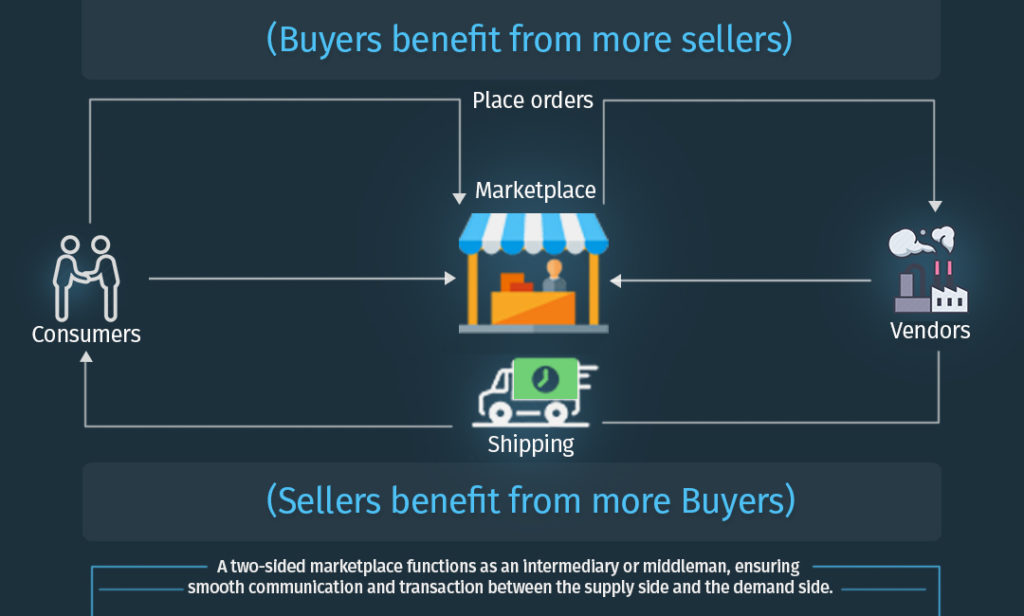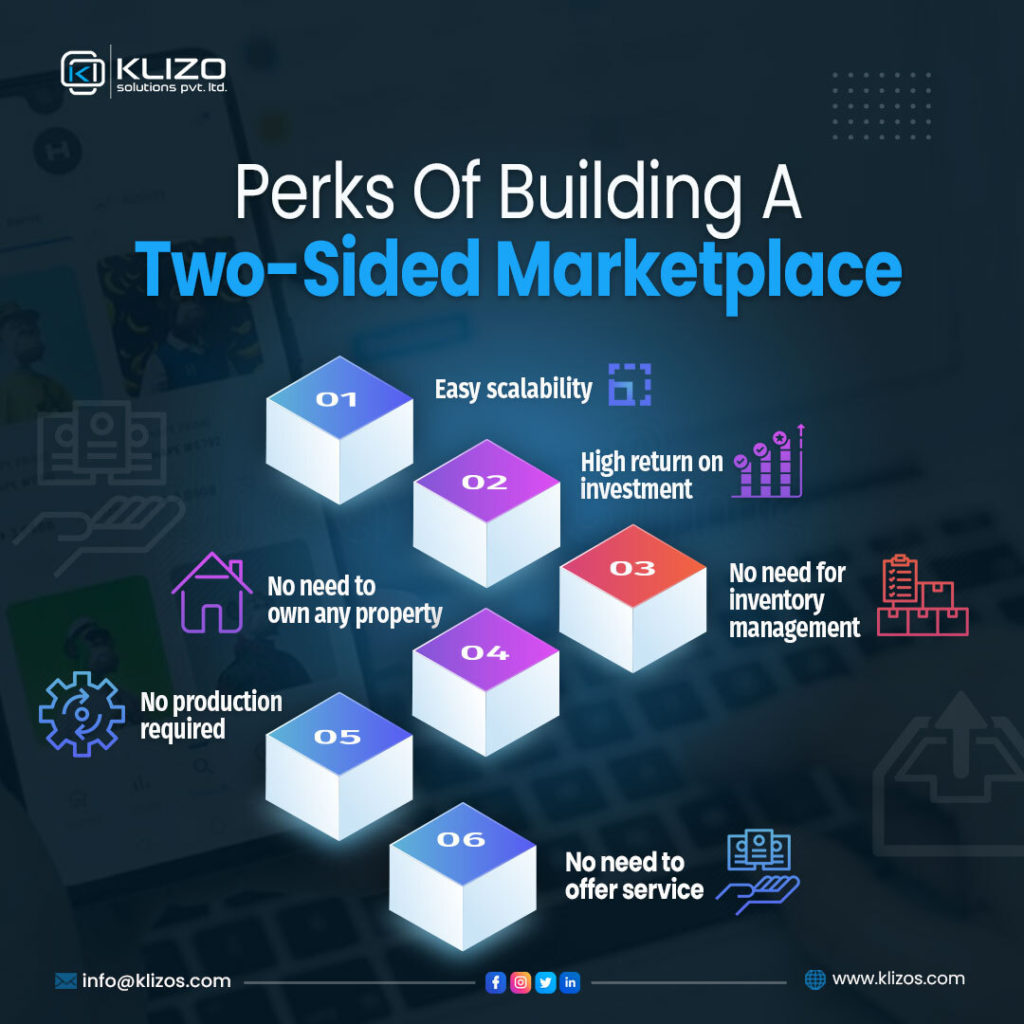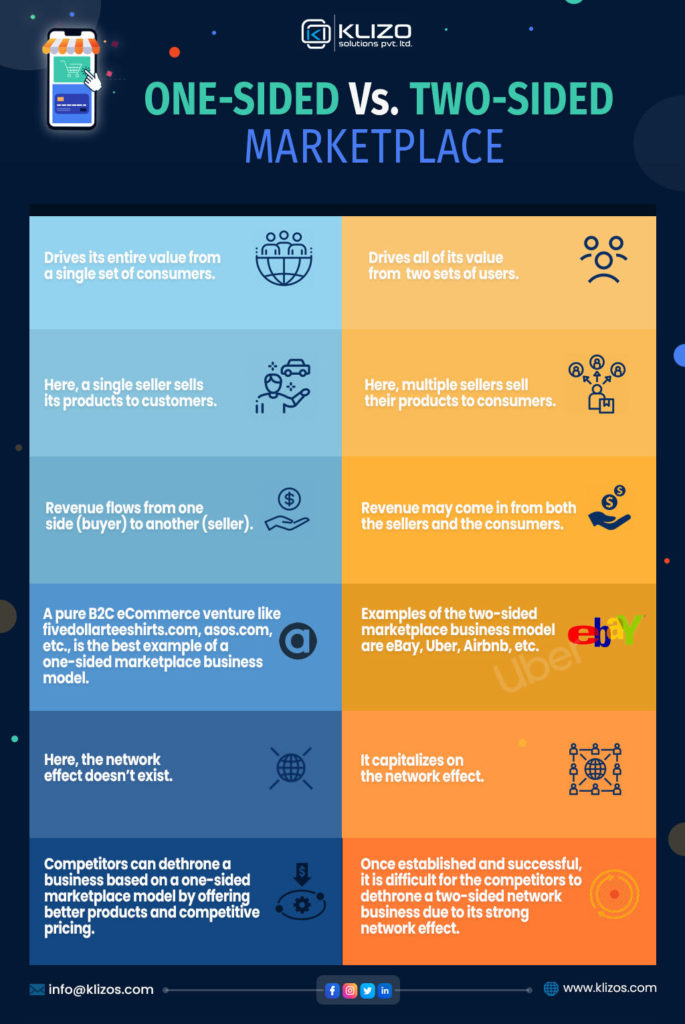


Have you ever thought about what is common between Amazon, Airbnb, eBay, and Uber? Yes, they are some of the firms generating huge revenues. But what else?
You might not have noticed it before, but they have another main thing in common. All of these most profitable firms run on a two-sided marketplace business model.
Also known as a two-sided market system/ multi-sided market/ multi-sided platform or MSP/ double-sided market, a two-sided marketplace is a business model that has gained rapid success in the last couple of years. No, it is no trend that will fade away anytime soon. The opportunities offered by this modern business model are likely to make it stay and rule the online business world. Its features are already considered essential for the way businesses will be conducted in the future.
Are you still clueless about what is a two-sided marketplace business model? Are you thinking about how it works and can benefit your business? Then read on as this article holds the answer to all your queries.
A two-sided network is an eCommerce business model that brings buyers and sellers together to create and exchange value. It provides a platform to two different user groups where they can effortlessly perform an economic exchange on a larger network and get benefited. In two-sided marketplace companies, value is given and received by both the service provider or seller and the consumers.
The intention of building a two-sided marketplace is to connect buyers and sellers. When you observe it like this, you will realize that the model is everywhere. Uber(in the transport industry), eBay(in eCommerce), Airbnb(in the housing market), Zillow, Amazon, Upwork (in the gig economy), TaskRabbit, etc., are all two-sided marketplace examples. The primary role of these companies is to make the value exchange process easier. However, Amazon is the odd one out here, as it employs both one and two-sided network models. But, this just further points out the many opportunities this business model has to offer.
Even Facebook, YouTube, Netflix can be considered two-sided marketplaces because they exist to function as intermediaries to match the demand and supply sides in the most efficient way possible. Credit card companies, such as American Express and PayPal are also examples of the two-sided network. They connect merchants and consumers and allow easy money exchange for services or goods.

The two-sided marketplace functions as an intermediary, allowing buyers and sellers to connect, identify products and transact. Here, the marketplace owner receives a commission for every transaction performed on the platform. The marketplace does not have to maintain or manage the inventory, own property, or take care of production.
Let us take eBay, the American multinational eCommerce corporation, as an example that does not have to hold an inventory, or TaskRabbit, which does not require a workforce. And how can we forget about Uber two-sided market! Uber does not need to own tons of cars to continue its business! On the contrary, Uber uses the drivers’ cars. But to innovate, they are looking forward to implementing their network of driverless cars. However, this is nothing new as the cab booking service has already generated a customer base with the two-sided marketplace business model.
The business model of a two-sided marketplace has numerous benefits to offer to all its participants, i.e., the buyers or the consumers, the sellers or the producers, and marketplace entrepreneurs or the marketplace owner.
The two-sided marketplace platform provides the buyers with numerous choices, which are not usually available in the traditional marketplace. Plus, using the platform is also hassle-free and offers a time-saving experience to the buyers.
And that is not all! As the producers or the sellers here face a lot of competition, they strive to offer competitive pricing and ensure quality standards of the products, which helps the buyers get the best offers and quality products. A double-sided marketplace makes it easier, cheaper, and faster for buyers to find what they are looking for.
Sellers find a lot more demand in a two-sided marketplace than they find on their own. For example, homeowners can build their websites to rent out houses online. But what if they enlist on Airbnb? As per the strategies for two-sided markets, the exposure would be way more than they would get on their website. Moreover, Airbnb would not charge the sellers anything unless the sellers make money. And it is also more convenient to list the apartments or houses on the platform than create a website for them.
In addition, the growth opportunities here are very high as the sellers have access to a large pool of potential customers. If a seller wants to build and grow its brand, a two-sided marketplace can be the ideal place to do so. It helps sellers reach more customers and use better tools.
Then there is also the time-saving factor. More and more people purchase from Amazon because they trust the platform more and not because they trust the seller. At times, users purchase from sellers they have never heard of before. But, still, they buy. And that is because of the reliability and trust they have in the platform, Amazon. Therefore, on a two-sided marketplace, a seller can save his time in trying to sell the products. Yes, a seller can utilize the time to build a reputation for himself.
A two-sided marketplace founder creates a platform for smooth economic exchange between two different user groups that provide the benefit of a larger network to each other. Since the marketplace owner or entrepreneur does not own any products and all it does is connect the two parties, i.e., the buyers and the sellers, the entrepreneur does not have to worry about production or inventory. It can save pretty big on what it would have spent if built on a one-sided marketplace model. Plus, the marketplace owner receives a small commission every time someone purchases the marketplace, despite not having to maintain any inventory, property, or production.
And there are the network effects, of course, a phenomenon in which the value of a service, product, platform grows as its usability increases, which also benefits the two-sided marketplace. For example, as the number of users increases, Facebook can provide better value to them. Network effects can also lead to a significant drop in customer acquisition costs. Plus, when the number of buyers increases, it boosts demand.
The growing number of two-sided marketplace startups like RangeMe, snappr, Droners.io, Robinhood, etc., clearly shows the increasing adaptation of the two-sided market model and its potential to grow in the coming years.
We already know that the gig economy is getting bigger, and about 36% of American workers are already involved in it. And guess what, one major part of the gig economy depends on the two-sided marketplace model. Two-sided marketplaces are the support system of the gig economy, but they are not limited to that. Such marketplaces are also very convenient for companies to find contractors. Businesses with a reliable model can grow their operations without bearing the burden of recruiting full-time employees. The opportunities for two-sided marketplaces are simply endless!
A rapidly growing number of people use two-sided marketplaces for transportation, food, entertainment, etc. And with every single interaction, the respective marketplaces continue to receive their cuts. As per the two-sided marketplace metrics report by Coresight Research, the revenue generated by these platforms will reach $40.2 billion in 2022, doubling up from 18.7 billion in 2017.

A two-sided market business model can take your business to great heights. But developing the right strategies for two-sided markets to make your business successful can be pretty challenging. One cannot just build a business overnight based on this model. It takes time to build communities of suppliers and consumers and get traction. But once the marketplace reaches scale and things start clicking, unseating it from its position becomes impossible because of the strong networks at play.
While this business model helps connect different consumer groups, they often face some challenges that hinder their growth, such as:
The day is not far when two-sided marketplaces will become mainstream! If you think carefully, you will see that you have already interacted with many businesses from this list of two-sided marketplaces yourself in the past couple of months! So yes, two-sided marketplaces can offer enormous opportunities for entrepreneurs. However, developing the platform is a real challenge. It can cost a lot of money and time as well.
If you need assistance with developing the components of a two-sided marketplace for the best prices, then contact us! We provide professionally tailored business solutions as per your requirements.
Besides, what do you think about this article? Do you think we should have covered other points, too? In that case, do tell us what you feel in the comments!
Previous article
Web Content Versus Web Design – Which Is More Important In A Website
Joey Ricard
Klizo Solutions was founded by Joseph Ricard, a serial entrepreneur from America who has spent over ten years working in India, developing innovative tech solutions, building good teams, and admirable processes. And today, he has a team of over 50 super-talented people with him and various high-level technologies developed in multiple frameworks to his credit.

Subscribe to our newsletter to get the latest tech updates.